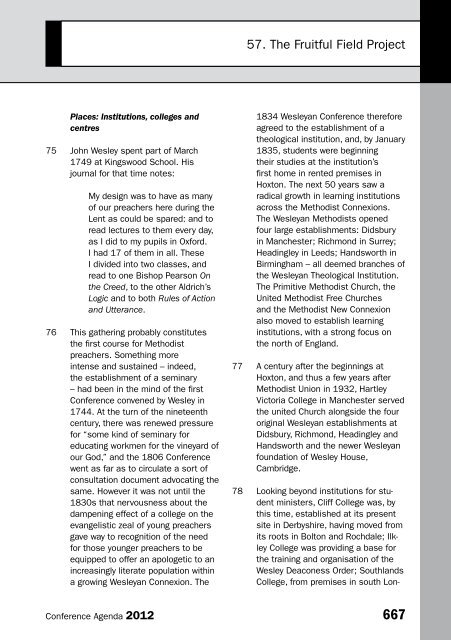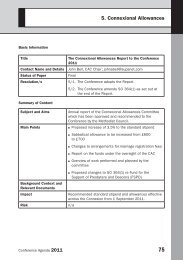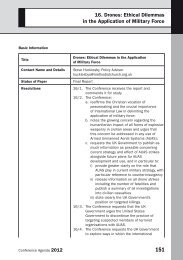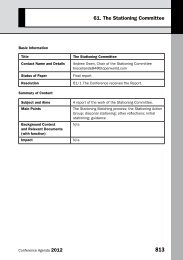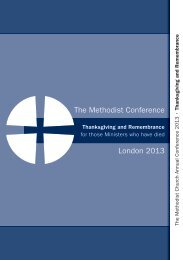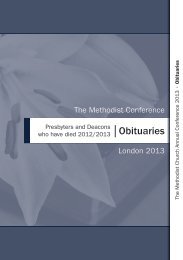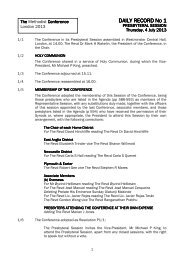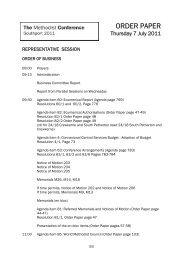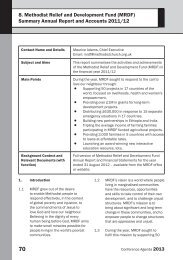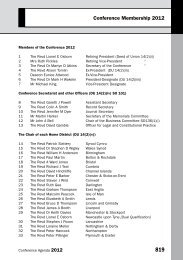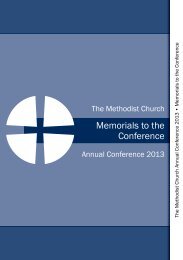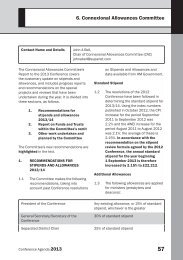Agenda Volume 3 - Methodist Conference
Agenda Volume 3 - Methodist Conference
Agenda Volume 3 - Methodist Conference
You also want an ePaper? Increase the reach of your titles
YUMPU automatically turns print PDFs into web optimized ePapers that Google loves.
57. The Fruitful Field Project<br />
Places: Institutions, colleges and<br />
centres<br />
75 John Wesley spent part of March<br />
1749 at Kingswood School. His<br />
journal for that time notes:<br />
My design was to have as many<br />
of our preachers here during the<br />
Lent as could be spared: and to<br />
read lectures to them every day,<br />
as I did to my pupils in Oxford.<br />
I had 17 of them in all. These<br />
I divided into two classes, and<br />
read to one Bishop Pearson On<br />
the Creed, to the other Aldrich’s<br />
Logic and to both Rules of Action<br />
and Utterance.<br />
76 This gathering probably constitutes<br />
the first course for <strong>Methodist</strong><br />
preachers. Something more<br />
intense and sustained – indeed,<br />
the establishment of a seminary<br />
– had been in the mind of the first<br />
<strong>Conference</strong> convened by Wesley in<br />
1744. At the turn of the nineteenth<br />
century, there was renewed pressure<br />
for “some kind of seminary for<br />
educating workmen for the vineyard of<br />
our God,” and the 1806 <strong>Conference</strong><br />
went as far as to circulate a sort of<br />
consultation document advocating the<br />
same. However it was not until the<br />
1830s that nervousness about the<br />
dampening effect of a college on the<br />
evangelistic zeal of young preachers<br />
gave way to recognition of the need<br />
for those younger preachers to be<br />
equipped to offer an apologetic to an<br />
increasingly literate population within<br />
a growing Wesleyan Connexion. The<br />
1834 Wesleyan <strong>Conference</strong> therefore<br />
agreed to the establishment of a<br />
theological institution, and, by January<br />
1835, students were beginning<br />
their studies at the institution’s<br />
first home in rented premises in<br />
Hoxton. The next 50 years saw a<br />
radical growth in learning institutions<br />
across the <strong>Methodist</strong> Connexions.<br />
The Wesleyan <strong>Methodist</strong>s opened<br />
four large establishments: Didsbury<br />
in Manchester; Richmond in Surrey;<br />
Headingley in Leeds; Handsworth in<br />
Birmingham – all deemed branches of<br />
the Wesleyan Theological Institution.<br />
The Primitive <strong>Methodist</strong> Church, the<br />
United <strong>Methodist</strong> Free Churches<br />
and the <strong>Methodist</strong> New Connexion<br />
also moved to establish learning<br />
institutions, with a strong focus on<br />
the north of England.<br />
77 A century after the beginnings at<br />
Hoxton, and thus a few years after<br />
<strong>Methodist</strong> Union in 1932, Hartley<br />
Victoria College in Manchester served<br />
the united Church alongside the four<br />
original Wesleyan establishments at<br />
Didsbury, Richmond, Headingley and<br />
Handsworth and the newer Wesleyan<br />
foundation of Wesley House,<br />
Cambridge.<br />
78 Looking beyond institutions for student<br />
ministers, Cliff College was, by<br />
this time, established at its present<br />
site in Derbyshire, having moved from<br />
its roots in Bolton and Rochdale; Ilkley<br />
College was providing a base for<br />
the training and organisation of the<br />
Wesley Deaconess Order; Southlands<br />
College, from premises in south Lon-<br />
<strong>Conference</strong> <strong>Agenda</strong> 2012 667


